 |
 |
Last Updated: Dec 15th, 2012 - 23:02:00 |
Exploring the mysteries of indigenous cultures--cultures that stand on a precarious edge of a primeval yesterday and a potentially tumultuous tomorrow--is a mission that Chris Rainier was born to. As a National Geographic photographer, photojournalist, and storyteller, Rainier travels to 14 or more countries each year. And unlike other globe-trotting photographers, Rainier's travel often involve slogging through waist-deep mud, trekking through leech-infested forests, battling malaria, eating everything from insect larvae to bats, sleeping in tree houses, and, sometimes, watching thousands of dollars of camera gear sink to the bottom of a river when a canoe tips over.
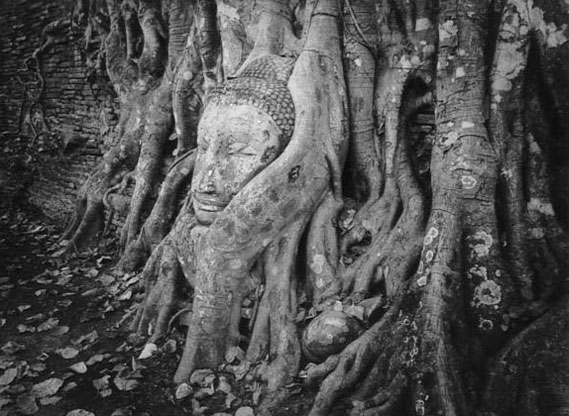 |
| © Chris Rainier |
Rainier's passion for documenting and preserving indigenous cultures, his passion for photography, and his seemingly unending patience with foreboding travel conditions and suspicious tribesmen, have netted the photographer numerous awards, as well as space in the top publications and galleries.
Rainier has received five National Press Association Picture of the Year Awards for his work. In addition to his work documenting indigenous cultures, Rainier also often covers international conflicts such as the siege of Sarajevo, tribal clashes between clans in Somalia and the United Nations troops, and wars in Sri Lanka, Cambodia, Sudan, Ethiopia and Rwanda. His photographs have appeared in Life, Time, National Geographic publications, the New York Times, Outside, Audubon, Conde Nast Traveler, Islands, German Geo, Stern, and publications of the United Nations, Amnesty International, and the Red Cross.
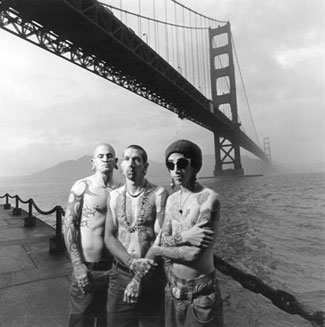 |
| © Chris Rainier |
Rainier's pictures are in numerous permanent collections around the world including: The International Center of Photography in New York, The George Eastman International House in Rochester, The Smithsonian Institution in Washington DC, The Bibliotheque Nationale in Paris, The Center of Creative Photography in Arizona, The Australian National Museum in Sydney, the Museum of Tolerance in Los Angeles, and The National Geographic Society in Washington DC.
A Storyteller with a Camera
Rainier is sometimes referred to as an anthropologist. Rainier, however, doesn't see it that way. Instead, he says, "I am a storyteller who uses a camera."
Gathering material for his stories began early in life for Rainier. As a boy growing up in South Africa, Rainier traveled extensively with his family. From the beginning, he carried a camera to document the beauty and mystery of indigenous cultures in far-flung places including Australia and Africa. And as he made his early pictures, the young photographer realized that there were cultural issues that he could not ignore.
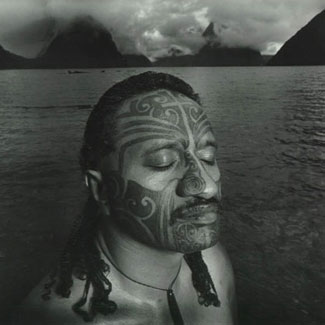 |
| © Chris Rainier |
"I think at a very early age, I knew that things were not perfect--it wasn't like the perfect travel magazine," Rainier says of the cultures he photographed. Ultimately, he knew that he wanted to combine his concern for social issues, his abiding passion for photography, and his strong sense of art into a profession where he could travel the world and learn--and, of course, earn a living doing it.
Learning from Ansel Adams
To make his dream a reality, Rainier studied photography, and after graduation, he became photographic assistant to Ansel Adams. Assisting Adams, who was then in his 80s, was "very much a privilege," Rainier says.
Working with Adams during the latter part of the photographer's life, Rainier says, "It was the time when he was putting his autobiography together, pondering his life and its meaning, and rushing to complete numerous projects. For the last 4 years of his life, I was helping him complete many of those projects and meeting a lot of great photographers and artists like Georgia O'Keefe--people who had a profound influence on my life."
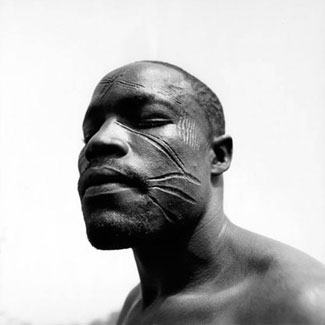 |
| © Chris Rainier |
During his years with Adams, Rainier recalls that the photographer had an unending sense of curiosity. Adams' curiosity was underscored when the 80-year-old photographer began learning the computer. "I remember when Steve Jobs came to give Ansel one of the early Apple computers. Ansel plugged it into the wall, and at midnight that night, he was still fiddling with it. From that day on, he was absolutely excited about it. That [incident] taught me a lot about never getting bored in life."
Today, Rainier has no time for boredom. Subscribing to the Bob Dylan quote, "He not busy being born is busy dying," Rainier believes that you "have to reinvent yourself and have a passionate curiosity for life."
A Road Less Traveled
After working with Adams, Rainier went on to make his mark as a photojournalist covering major conflicts and disasters for Time and other magazines. Yet. all the while, he continued his documentary treks to New Guinea, West Africa, Borneo, Nepal, India, and Afghanistan among others.
 |
| © Chris Rainier |
Rainier's documentary work resulted in three books, Keepers of The Spirit, Where Masks Still Dance, and, his most recent book, Ancient Marks that documents traditional tribal tattooing around the planet. Rainier is also a popular workshop instructor at the Maine Photographic Workshops, the Santa Fe Workshops, and Anderson Art Ranch.
Currently, Rainier is the director of the international Cultures on the Edge Web site, part of the National Geographic Society's Cultures Initiative. He is co-director of the team producing the Cultures Program at National Geographic and is a contributing editor at National Geographic Traveler.
Rainier's current work is an avenue to realize his ultimate dream of "being able to create a way that we can hear stories from the cultures themselves." Rainier explains, "The program I co-direct at the National Geographic is really about empowering still photographers, filmmakers, writers, musicians from indigenous cultures to tell their own story."
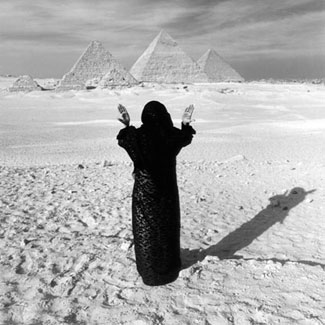 |
| © Chris Rainier |
The ongoing "All Roads" photography project is part of Rainier's current work. In this project, photography portfolios from indigenous, under-represented cultures were solicited. Then four photographers, one each from South Africa, India, Mexico, and Brazil, were selected to receive camera equipment that will empower them to tell their stories.
Rainier says, "With the technology shift that's going on and the world being connected, giving indigenous tribal people the opportunity to tell stories and do music is what it truly means to be human."
An Approach to and a Philosophy on Photography
Rainier shoots predominately Kodak TriX black-and-white film with his Canon and Hasselblad gear. He prefers black-and-white because it "comes closer to representing the metaphor and the spiritual sense of the culture more than color." Rainier adds that he shoots color film when shooting for the National Geographic.
When he travels to indigenous cultures, Rainier says, "I try to slow down and begin to really tune into their way of life, to understand and respect their way of life and alternative ways of thinking about things. An American would look at a mountain or a forest and see potential natural resources, something for comfort. An indigenous people would look at a tree or mountain and realize that it is a sacred god. Learning to understand the world on multiple dimensions is a privilege of being able to spend time with these people."
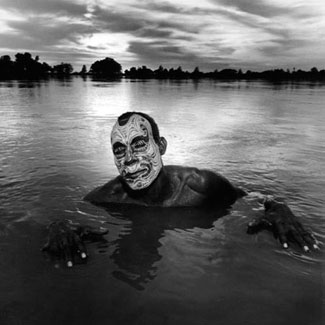 |
| © Chris Rainier |
Often limited to only non-verbal communication, acceptance in indigenous cultures isn't guaranteed, and sometimes it is slow coming. But Rainier is patient and respectful--traits that often ultimately win his acceptance into the culture. On some trips, he may wait weeks before making his first picture.
After one journey, Rainier summed up his experience. ""I learned from the forest people how to fit quietly into another culture, how to ask a useful question, when to remain silent, and how to yield control to circumstance and simply be there."
The photographer's philosophy on his photography is at once complex and simple. "I'm trying to create a sense of equivalency," Rainier says. "I would hope that people who look at the images not only see [the culture], but they also have a feeling of what it felt like to be there. When I photograph sacred sites, spiritual experiences, indigenous dances, and tribal experiences, I'm really trying to have people have a feeling of what that culture feels like visually and spiritually."
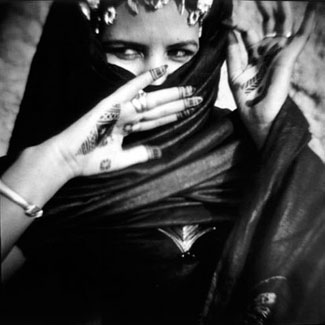 |
| © Chris Rainier |
Advice for Aspiring Photographers
The seasoned photojournalist has three simple pieces of advice for aspiring photographers:
- Follow your passion.
- Believe in what you do.
- Put off short-term gains for long-term goals.
After years of shooting in places on the map that are marked with a designation, "no data available," it stands to reason that Rainier would have one or two favorite images. That is not, however, the case. A favorite shot is still elusive for Rainier who says, "I always am stretching to make that perfect shot. So for me, my favorite shot is the one I haven't taken yet."
View more of Chris Rainier's images on his web site.
This article brought to you by PHOTOWORKSHOP.COM. Let us know if you found this article useful and tell us what kinds of articles you'd like to see in upcoming issues. Send your comments and ideas to the editor.
Top of Page
|
|
| |
